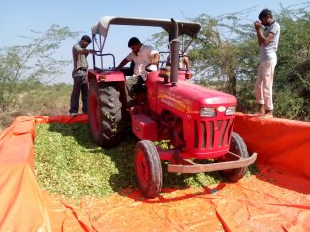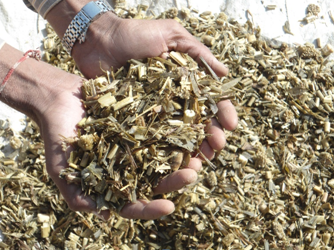Nutrients are essential for the growth and production performance of all living beings. Feeds (concentrates) and fodders (roughages) make the nutrition of livestock. Concentrates are livestock feeds that are low in fibre content and high in proteins and other nutrients. Whereas roughages are mostly fibres. Roughages consumed as feedstuffs by cattle and buffaloes include grazed roughages as pasture, preserved roughages. Like hay and silage, and crop residues/by-products such as straw, stover, and hulls. Besides green fodder, roughages in the form of straw, hay, and silage comprise the bulk of the nutrition of dairy cattle and buffaloes.
What is silage?
Forage that is still green and nutritious can be conserved as succulent roughage almost in its original condition through a natural ‘pickling’ process known as fermentation. Anaerobic fermentation of carbohydrates present in forage results in the production of lactic acid which acts as a preservative. Silage is made in the absence of air in a suitable silo. Forage conserved this way is called ‘ensiled forage’ or ‘silage’.
The silage is made when green fodder is surplus and can be kept for two to three years without deterioration in its quality. Low pH of silage makes it germ-free. The good taste and sour-sweet aroma of silage make it palatable to animals. Silage can be fed at any time of the year, especially in lean seasons when green fodder is not available to feed dairy animals.
Silage making:
Maize, Oats, Jowar, Bajra, Hybrid Napier, cultivated and natural grasses rich in soluble carbohydrates are most suitable for ensiling. The crop should be harvested between flowering and milk stage when it contains 30-35% dry matter and chopped before ensiling. The quality of silage can be improved with the use of suitable additives. Such as molasses, urea, common salt, formic acid etc.
Silage is prepared in an air-tight structure (silo) designed for the preservation of high moisture fodder silage. Low capacity Pit and Surface silos are suitable for small and medium farmers. Normally, one cubic meter space is required for ensiling 500 kg fodder. The capacity of a silo should be calculated based on the number of animals to be fed and the length of the feeding period.
The crop that is to be ensiled is harvested and chopped into small pieces of 2-3 cm size for better packing. Chopped fodder should be evenly distributed throughout the silo and pressed manually or by tractor, layer by layer of 30-45 cm. Filling and pressing should be completed as fast as possible.
Additives are mixed during the filling of fodder in the silo if needed. After filling and pressing, the silo is covered 3-4 feet above the ground level with a thick polythene sheet. Then the weight is put using a mud layer/sandbags/used tyres on the sheet to prevent the entry of air and water. The silage would be ready for use in 6-8 weeks. Good silage is tender, has an acidic taste and smell, and has yellowish or brownish-green color.

Silage can also be made in plastic bags of various sizes suiting farmers’ needs. For this, chopped green fodder is filled in the bag and pressed as hard as possible to remove air. And to create anaerobic conditions inside the bag. Once the bag is full, it is sealed properly. The silage bag is stored away from direct sunlight and protected from rain. After 3-4 weeks’ time, good quality silage is ready for feeding animals. To retain the quality, the silage bag should be closed quickly after removing the day’s requirement of silage. If silage is not needed immediately, the bag can be kept for 12 months or so.

Advantages of silage feeding:
- Silage is a good source for replacing green fodder as it is succulent, nutritious, and easy to digest by dairy animals for producing more milk.
- Crops can be ensiled when the weather conditions do not permit their conservation ashay or dry fodder.
- Enhances green fodder productivity by improving harvesting intensity. So the use of silage makes it possible to keep more animals on a given area of land under fodder crops.
- Silage provides good quality fodder in any season of the year, to sustain milk production.
- Crop from a larger area can be stored in less space as silage than as dry fodder.
- Silage feeding controls parasitic diseases as parasites present in different stages in green fodder are destroyed during ensiling.
Silage Making Demonstrations:
Considering the importance of silage as a nutritious roughage, silage making demonstrations were carried out as a part of fodder development program. Under the National Dairy Plan-Phase I (NDP-I) of Govt. of India. NDDB Dairy Services facilitated Maahi and Payaas Milk Producers Companies (MPCs) in Gujarat. And Rajasthan respectively in organizing 281 silage making demonstrations.
These demonstrations were witnessed by 5400 farmers and as a result, 357 farmers adopted silage making to feed their dairy animals. The farmers who cannot make silage are purchasing silage from local market, if available. Looking at a certain demand for silage, a few MPCs have started procuring silage and supplying it to their producer members. So far, 175 MT silage has been procured and supplied to members by MPCs.
Also, read…
Bacterial Silage Inoculants vs. Organic Acids
Conclusion:
Silage is the best option as a replacement of green fodder. Since green fodder is not available in the lean season. Silage making can help farmers in providing succulent and nutritious roughage to their dairy animals round the year. Silage making enhances the fodder productivity by increasing crop intensity. It can maintain the production level of milking animals even when green fodder is not available. Silage making is cost-effective and farmers are to invest a little amount for construction of silo and buying a chaff cutter. To economize the dairy farming, farmers must adopt silage making and feeding it to their cattle and buffaloes.

Authors:
Dr.Lokendra Chauhan
Dr. Rajesh Roshan, and
Dr. MU Siddiqui
NDDB Dairy Services, New Delhi.















